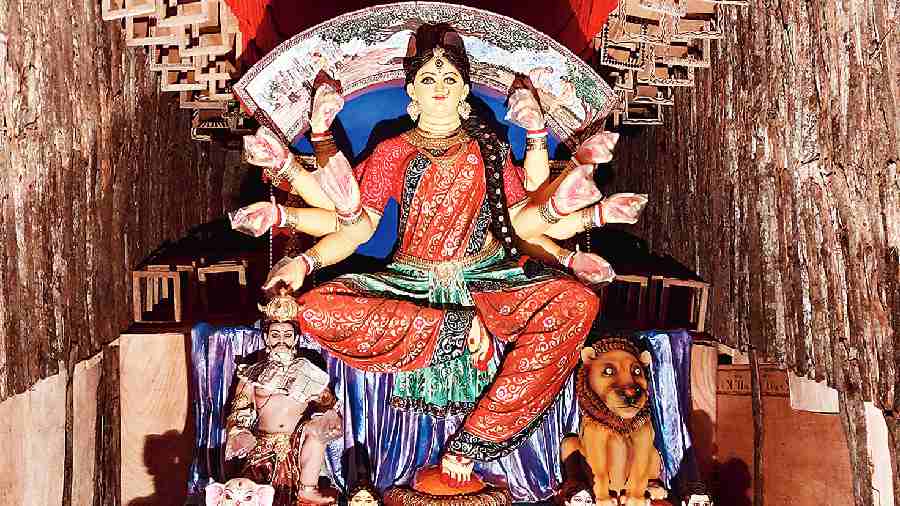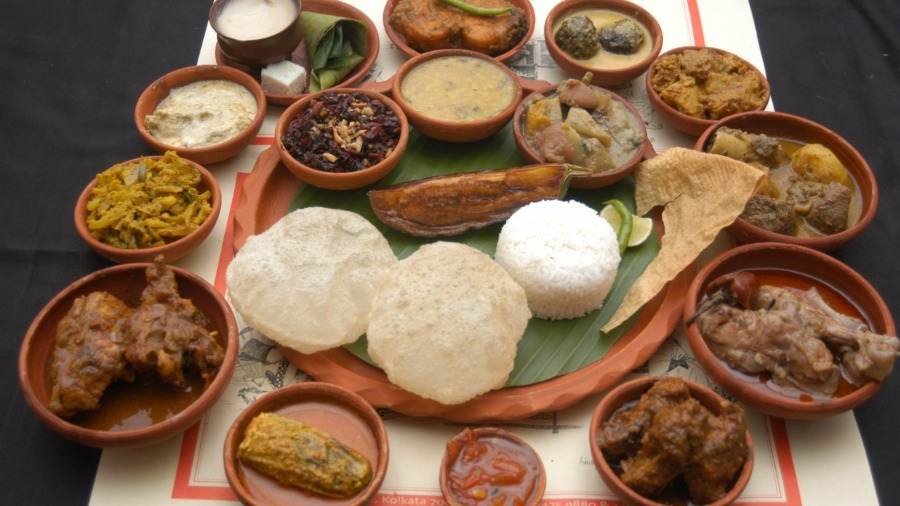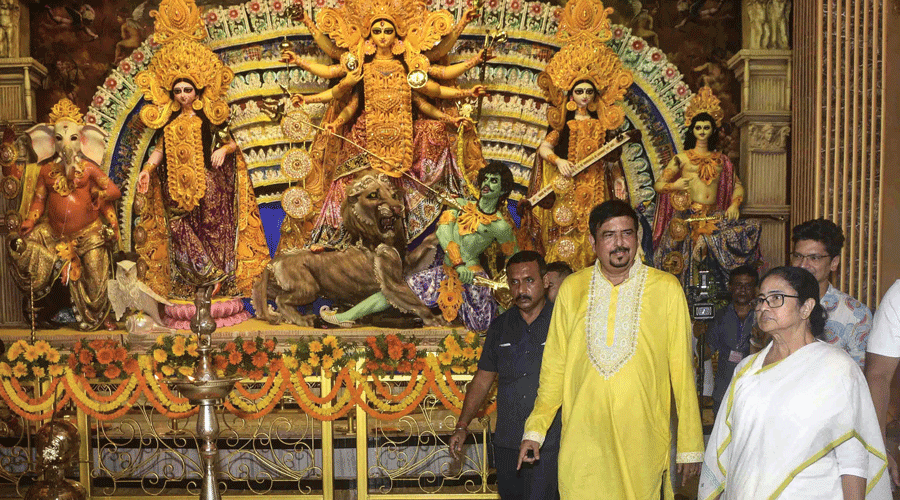Sreebhumi
Year: 50th
Budget: Undisclosed
The look: The puja which brought VIP Road to a standstill last year has constructed a replica of St Peter’s Basilica in Vatican City. The structure is 92ft high and 54ft wide, utilising the entire available width of the field. The ceiling inside is in keeping with Maderno’s nave and has pilasters that are identical in look to the original’s marble surface. The pandal will flaunt 35 oil paintings, copies of the famous works on display at the basilica. The theme song has been sung by Shaan and Dipanwita.
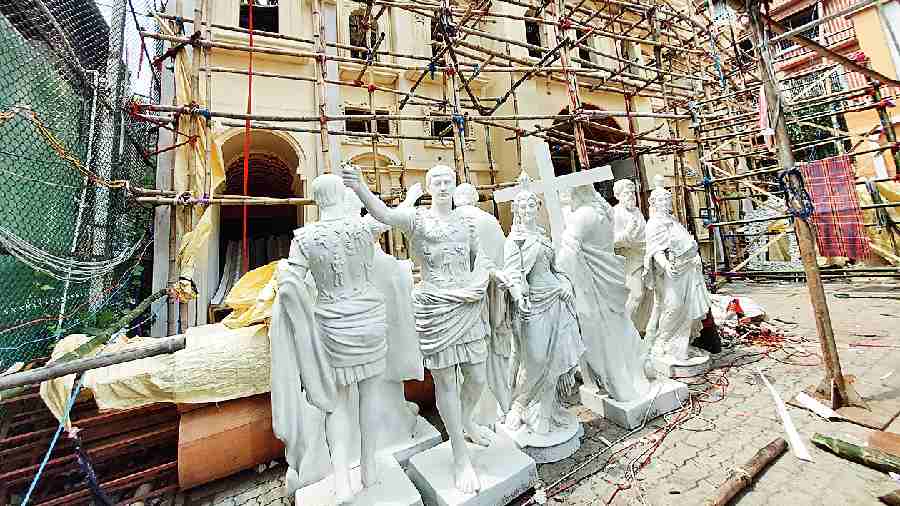
A slice of Vatican City at Sreebhumi. Sudeshna Banerjee
Laketown Adhibashibrinda
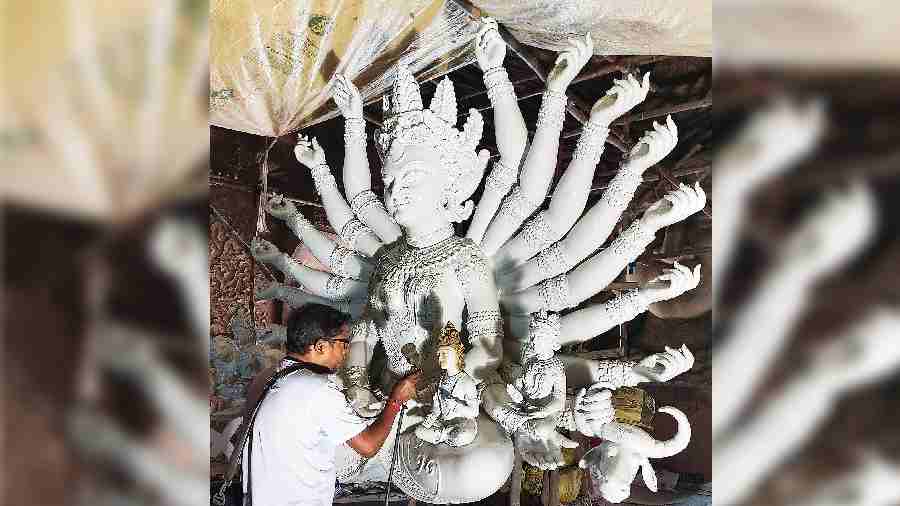
Year: 60th
Budget: Rs 33 lakh
Theme: White Ravan
The look: The pandal is a cave that is an ode to Ravan with eight statues showcasing his various capabilities. A deft musician, he is seen playing the veena. An able ruler, he is seen embracing a young subject. A scholar, he is seen writing his ayurvedic treatise, Arkaprakasam. A Shiva devotee, he is seen immersed in worship. In another, the author of the astronomical treatise, Ravansanghita, is doing measurements with a compass.
The inspiration behind the pandal, 33ft wide and 120ft deep, is the mythical palace of Ravan in Sigiriya, Sri Lanka. Cave paintings from there have found place on the pandal walls.
The goddess, crafted by Subal Pal, has a weather-beaten marble finish, is seated on a lotus surrounded by a moat and, like Ravan, has 20 hands. Her children are seated on the palms of Her extra hands.
Organiser speak: “Ravan was a virtuous king with many qualities that most people are unaware of. But all that got eclipsed because of his failure to control his anger. This serves as a warning to us to keep our emotions in check and also gives out the message to hate the sin and not the sinner,” said Sabyasachi Dutta, a club member.
Pradeep Sangha, Notun Palli

Year: 42nd
Budget: Rs 18 lakh
Theme: Rudra
The look: With the load of vices getting heavier, theme-maker Prasanta Pal is visualising Shiva retiring to the netherworld. Only his third eye is still visible. The same is true for the goddess’s trident, with only the three tips visible above ground. The idol is placed inside the third eye which forms a crevice in the facade. The dreadlocks of Shiva, made of coconut coir, spread on both sides which also have tiger skin and damaru, both accessories of Shiva. Plastic bottles have been shredded to create purple petals of datura, a flower dear to the god.
Dum Dum Park
Yubakbrinda
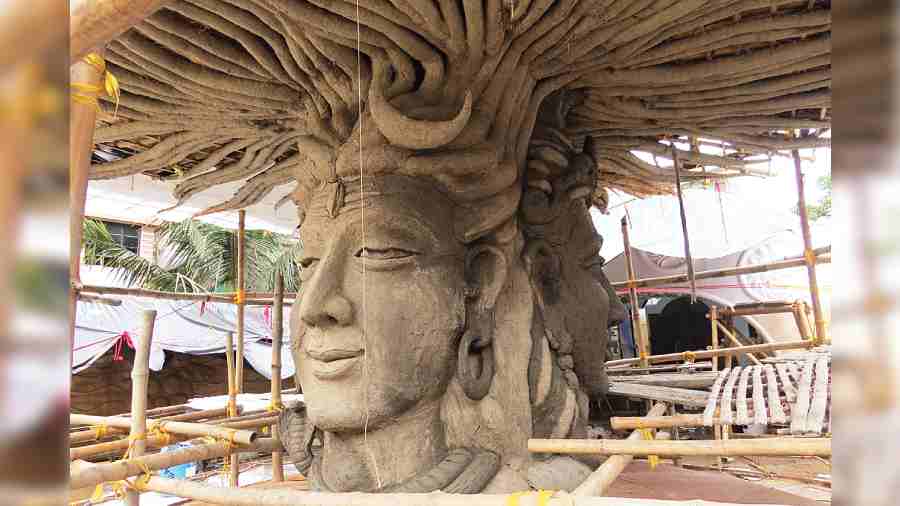
Year: 56th
Budget: Rs 10 lakh
Theme: Adi, anta, ananta
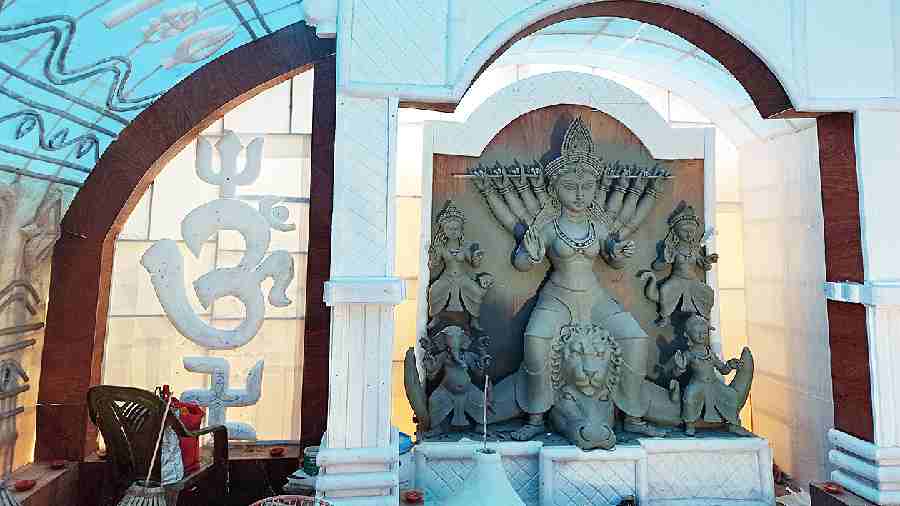
The look: Huge faces of the Trinity, Brahma, Vishnu and Shiva, welcome and bid goodbye to visitors, being placed around a central pillar. The walls have a sand finish. Motifs of the weapons in the Devi’s hands dot the sides and the ceiling in the sanctum sanctorum.
Bharat Chakra

Year: 22nd
Budget: Rs 22 lakh
Theme: Introspection
The look: A cylindrical pillar stands at the centre of the first chamber of the pandal to which is affixed a variety of leaf puppets (talpatar sepai) from Odisha. At its base are votive clay figurines that are offered in places of worship in Rarh Bengal districts. On the sides are faceless human figures in relief on clay panels, some erect, some lying prostrate.
On the walls are niches in which ashes of departed ones stand beside articles of their daily use as testimony to the identity, be it a pair of spectacles or a doctor’s handbag or a container. Around the niches are dozens of faces, from different professions, classes and castes.
Behind the towering goddess, on a giant screen, a pyre burns at a burning ghat, relegating all ego and vanity to ashes. The goddess is seated, with patachitras showcasing slices of babu culture permeating her hands, her robes and the backdrop.
Artiste speak: “People, blinded by ego, put a tag of social or religious identity on themselves yet once the tag is removed they are all the same. Our theme song, the Lalan Fakir number Ami ami kore rendered by Parbati Baul, gives out this message. In fact, the dreadlocks in relief that spread across the pandal walls are representative of the baul philosophy of selflessness,” said Anirban Das, the theme maker.
Tarun Sangha
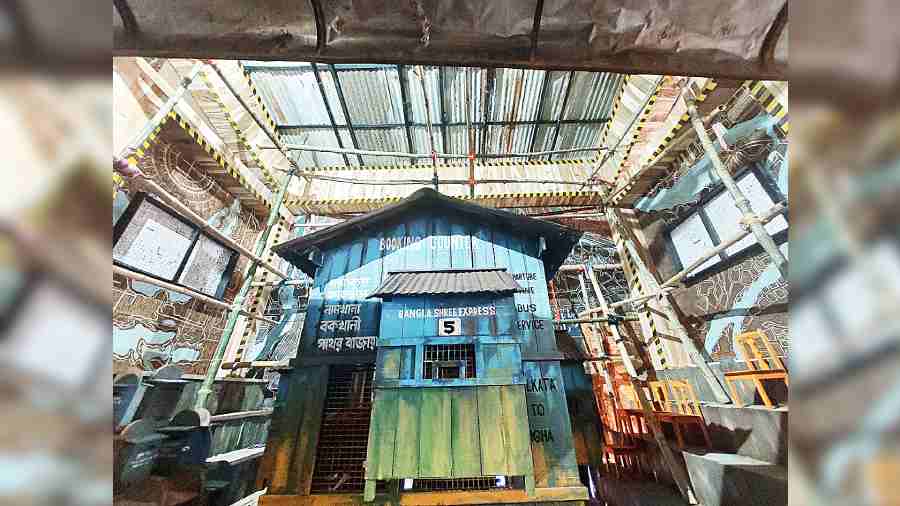
Year: 37th
Budget: Rs 36 lakh
Theme: Choloman (Journey of life)
The look: Discarded items having to do with journeys like tyres and bus tickets have been recycled as decor. A giant compass hangs from the ceiling at the entry. Two wooden ticket booking stalls stand facing each other. There are windows indicative of urban hostels (messbaris) on both sides of the goddess. The front portions of an autorickshaw and a rickshaw, modes of public transport, jut out of the walls overhead. The goddess herself has one foot ahead of the other, indicative of motion, as though she has come out of the temple.
Dum Dum Park Sarbojanin
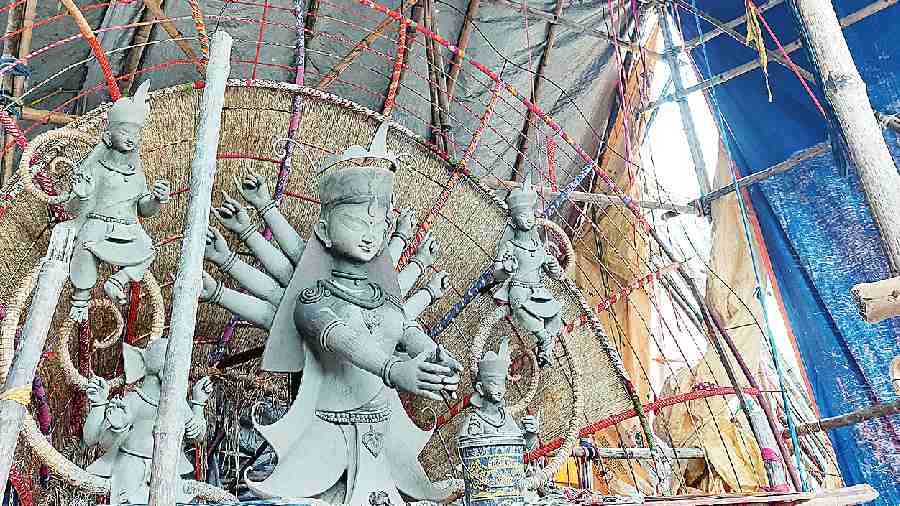
Year: 71st
Budget: Rs 10 lakh
Theme: Shobdo-shurey sarbojanin
The look: Artist Dhiman Sutar wants to create music out of the most mundane noises. Thus several sounds, be it the ringing of brass bells or sounds of traditional playthings — will be created by motorising the items.
Above the idol, an oversized replica of a vinyl record will continually rotate. The goddess will be suspended from a rod on a circular framework of rods shaped like the curved brass horn funnel of a gramophone record player. On the sound system will be heard a singer’s vocal training. Three sides of the pandal will be open, with the sound as if spreading out over the series of outstretched bamboo poles.
Dumdum Tarun Dal
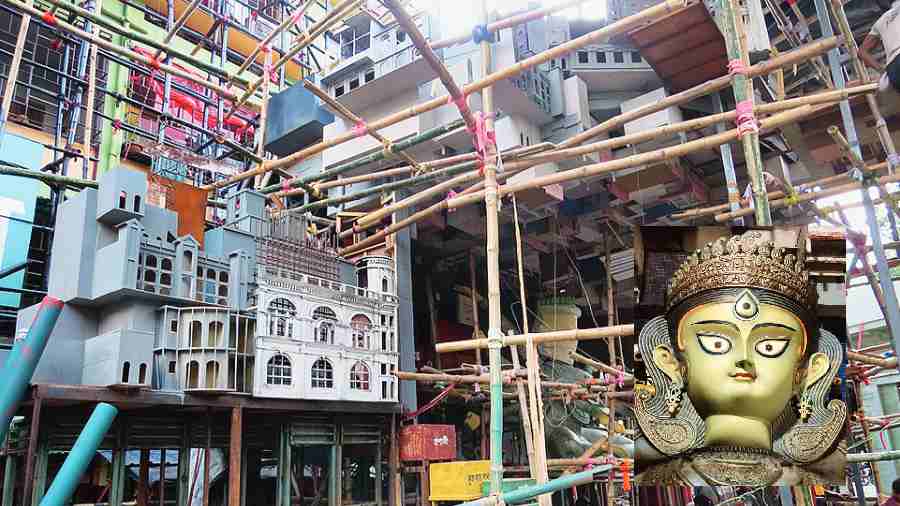
Year: 45th
Budget: Rs 50 lakh
Theme: City of joy
The look: A British official in uniform and with a telescope in hand stands at the entry, taking one back in time to the dawn of the colonial era. An old Calcutta map is spread out. And from the adjacent verandahs big telescopes jut out, symbolising a search for the city. As one walks in, above unfolds an inverted view, as if seen from the city’s underbelly — Ganesh Pyne’s studio, an old photography studio with bromide prints hung out to dry... Up ahead, theme-maker Pradip Das pays tribute to Gopeswar Pal, the pioneering idolmaker, by building Pal’s studio at a side. Above it stands a gantry crane used in Metro Rail construction, incorporating a flash of modern-day Calcutta. Shipyard containers form the goddess’s backdrop. At another corner, stands an old printing press.
Above the pandal, stand cheek by jowl structures that make the modern city. The goddess as if holds it all up on two of Her outspread palms.
Kestopur Prafulla Kanan
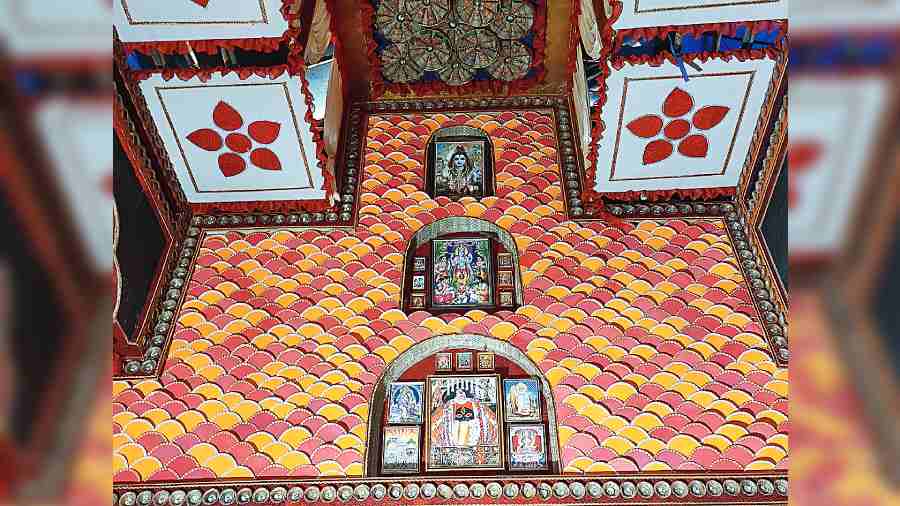
Year: 20th
Budget: Rs 20 lakh
Theme: Proti ma tei protima
The look: A key component of the ritual that women take part in together is offering of naibedya. The pandal is decorated with various kinds of plates — sal leaf plates, paper plates, dala, clay ghot in which offerings are made. Framed paintings of goddesses in calendar art style are hung in places. The pandal is a celebration of fertility in women. There is a representation of kumari puja too as the virgin is seen as fertility of the future.
Bondhu Mahal
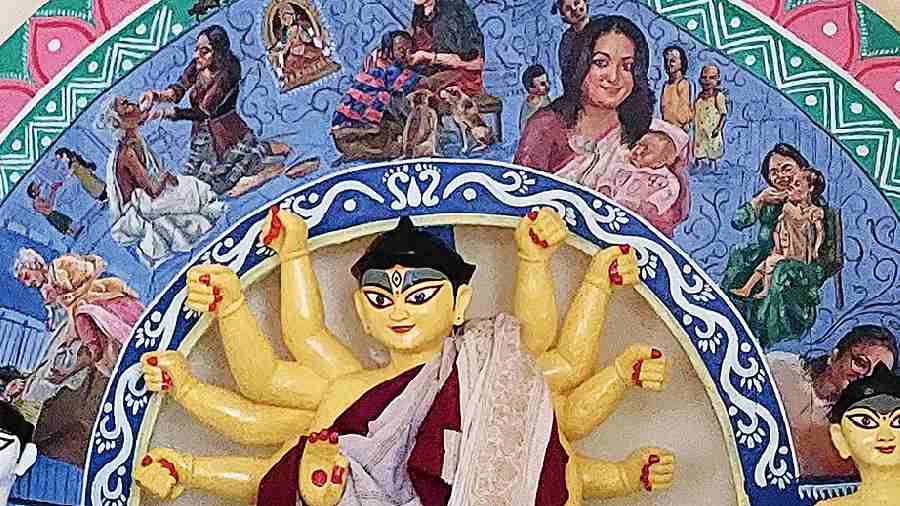
Social worker Papiya Kar on the chalchitra of the idol
Where: Ashwininagar, Baguiati
Year: 42nd
Theme: Bhagarer Ma
The look: The pandal celebrates the life and work of Papiya Kar, a woman from Gede who feeds 200 people at her Annapurna Saraighar beside Ranaghat station and teaches destitute children at Dharamtala bus shelter in Calcutta. There will be a silicon statue of the woman as well, with a tiffin carrier in hand. She will also be on the backdrop of the goddess. A platform with tracks and an overbridge which can actually be climbed give the pandal a feel of a rail station.
Artists peak: “Papiyadi is also crafting an idol for us made of paper pulp. The remuneration she gets for that will sponsor Puja clothes for the children she feeds and teaches,” said Samrat Bhattacharya, the theme-maker.
Ultadanga
Bidhan Sangha

Year: 54th
Budget: Rs 35 lakh
Theme: Moksha
The look: Visitors enter through zigzagging ladders. Inside Prasanta Pal’s pandal, there are clay, straw and cement sculptures covering almost every inch of the walls. People are climbing ropes seeking salvation in life through their work. In the next section, those who succeed in their career quest, stand erect on top while those who have failed lag at the base, in defeated postures. The idol stands in the middle allowing visitors to walk around and notice the Dashamahavidya forms in miniature carved on her back.
Telengabagan
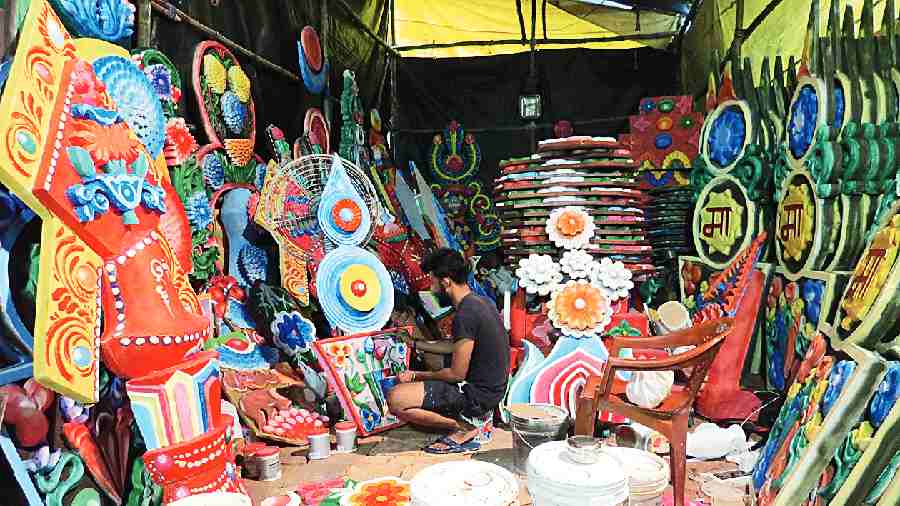
Year: 57th
Budget: Rs 22 lakh
Theme: Torma
The look: The Buddhist offering, made of barley and yak butter, comes in colourful designs. There are 22 types of torma on view, with the largest, at 40ft being the sanctum sanctorum itself.
The idol, being crafted by Pradip Rudrapal next door, will have northeast influence.
Sangrami, BRS3
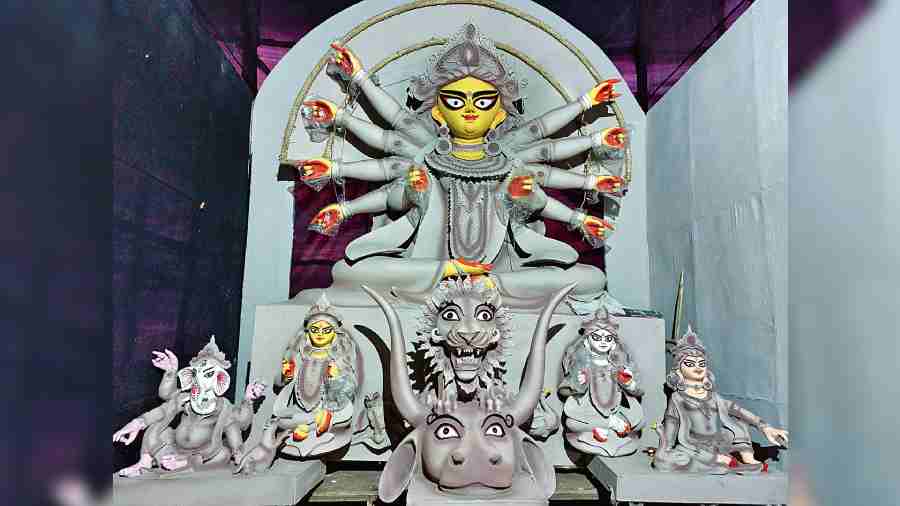
Year: 60th
Budget: Rs 20 lakh
Theme: Mulyobodh (values)
The look: A ladder outside symbolises how we climb up in our career trampling others. A rickety bamboo formation inside is our spine at the top is a platform on which a sofa is placed. The sofa is a symbol of the capitalists at whose alter we have offered our spine. The most exploited are the labourers, masons and farmers. The pandal is divided into the three segments on the three necessities — food, clothing and a roof overhead. A broken boat hangs overhead in a nod to the fisherfolk. On the walls spinning wheels spin a gamchha or a sari. The sanctum sanctorum does not have a proper ceiling as masons often lack a roof overhead.
Kankurgachhi
Jubakbrinda

Year: 93rd
Budget: Rs 30 lakh
Theme: Rup-antar
The look: The pandal holds up a mirror to the agony of transwomen, those who are born male but want to be female. A series of faces hangs atop the gate with colourful veils covering the face. This represents the awakening of desire in a biological man to transform into a woman. The entry to the pandal is through a tunnel with black walls, as if one is entering the mental recesses. Manabi Bandyopadhyay, the first transgender college principal in the country, has spoken on the puja’s theme which will be shown on a screen at the entry into the sanctum sanctorum.
Artistespeak: “Child-bearing is not the only marker of a woman, as is shown by Ma Sarada and Mother Teresa. These transwomen are female too, irrespective of whether they have succeeded in getting the sex change operation done or not. The mental agony they undergo in being a woman trapped in a man’s body to them is more than the trauma of going under the knife,” said theme-maker Somnath Mukherjee.
Mitali

Year: 86th
Budget: Rs 15 lakh
Theme: Durgotsab
The look: The pandal encompasses various stages of the ritual, from kathamo puja to darpan visarjan. Two articles integral to the ritual, the conchshell and the hand bell, are a key element of the decor. In one corner, a radio is placed on a table, signifying the broadcast of the Mahishasuramardini programme. Other corners have depictions of kala bou snan and kumari puja.
Swapnar Bagan
Year: 69th
Theme: Bastob (reality)
The look: Barks of trees line the walls of the pandal.
Artiste speak: “We are a confused lot. On one hand, we want to stop cutting trees. On the other, we want to stop using plastic and are returning to paper bags but this will result in the felling of more trees,” said theme-maker Samrat Bhattacharya.
Beleghata
Beleghata 33 Palli
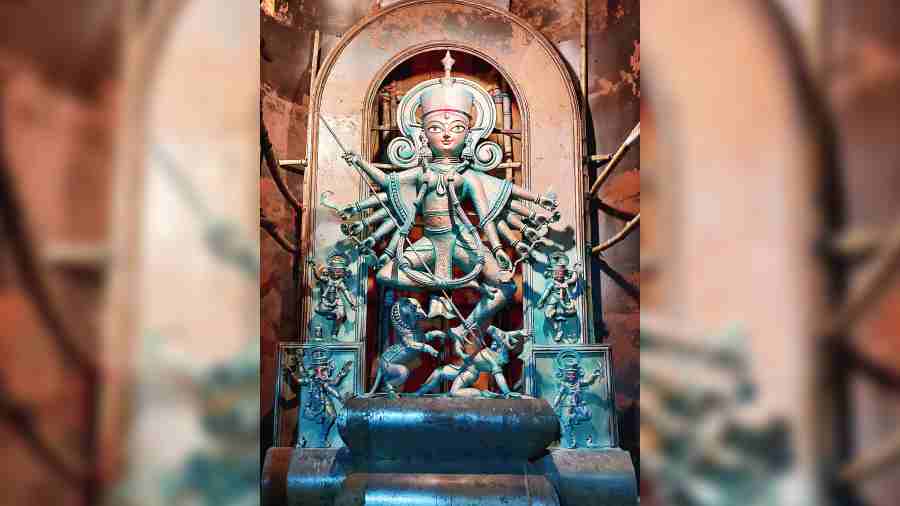
Year: 22nd year
Budget: Rs 55 lakh
Theme: Chup-katha
The look: This edition is a continuation of last year’s theme of people being locked down in isolation. The most arresting sight is of a bulldozer at the centre, with the road it has freshly laid out rising skywards. Sets of two chairs facing each other are rocking from the base. Faces in various expressions of speech and silence dot the walls. Two rolling machines stand by the entrance. In this citadel of metal and plywood, the goddess has a metallic finish.
Artistespeak: “The pandemic has bulldozed us into submission to forces beyond our control. The chairs, standing for our status in life as also the posts we hold in our career, have ceased to be constant in the post-lockdown world. People are being forced to switch livelihoods. At another level, with the Unesco heritage tag drawing Durga puja on a global stage, the road that we have created with actual bitumen coating connects to CIT Road and through it, spreads out to the road network across the world,” said Sibshankar Das, the theme-maker.
Sandhani
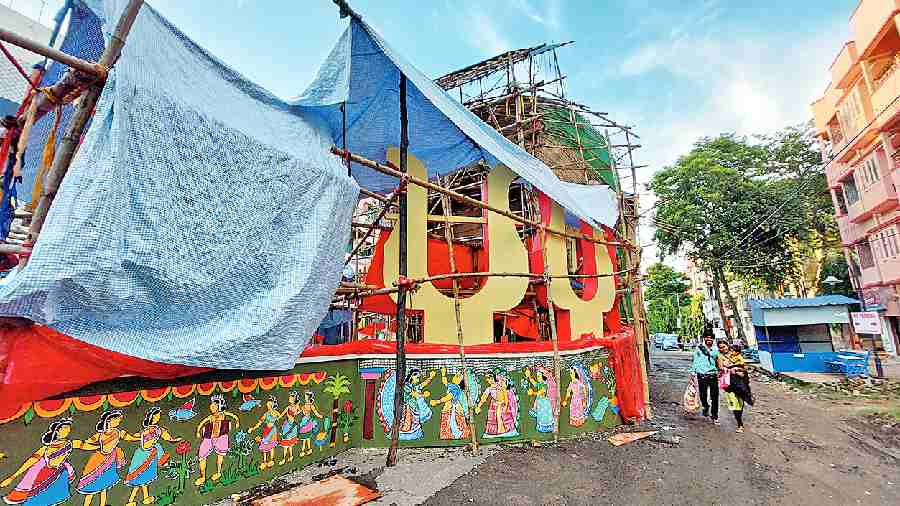
Year: 53rd
Budget: Rs 25 lakh
Theme: Sindur: bhalobashar rong na narisotwar jotichinho
The look: Outlines of faces of women dot the walls. At the centre is a 9ft vermillion container with silver finish in which the deity will stand.
Artiste speak: “The vermillion is a key identity marker for a woman, be it at a wedding or at sindur khela on Dashami. But once the husband dies and the vermillion is wiped off a woman’s hair parting, so much in her life changes,” says Rupak Basu, the theme-maker.
Nabamilan
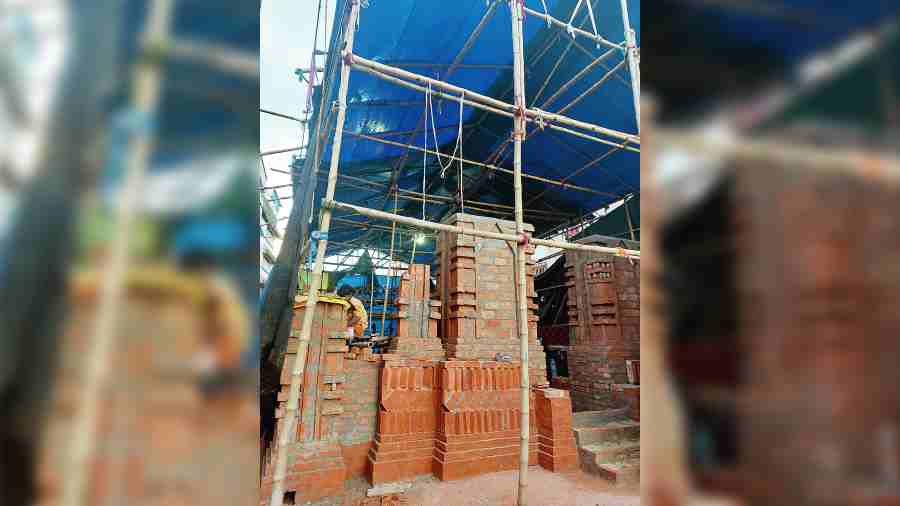
Year: 95th
Budget: Rs 12 lakh
Theme: Puratoner Puratoni
The look: A team of artistes from Santiniketan is building installations in brick in a nod to the terracotta temple art of Bishnupur.
